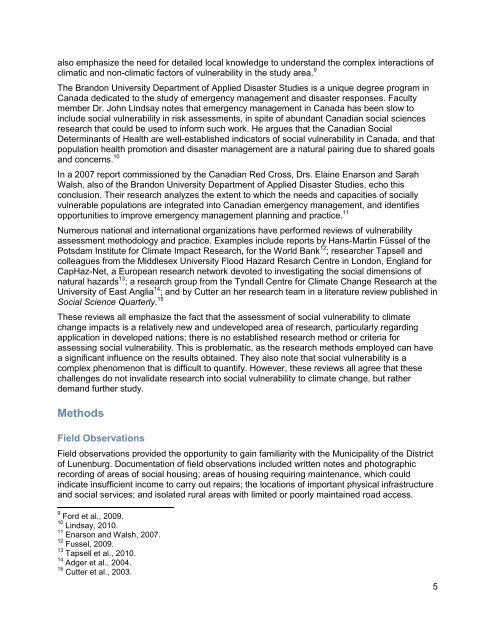Lunenburg Part 2 - Section 5 - Social Vulnerability - August 30.pdf
Lunenburg Part 2 - Section 5 - Social Vulnerability - August 30.pdf
Lunenburg Part 2 - Section 5 - Social Vulnerability - August 30.pdf
You also want an ePaper? Increase the reach of your titles
YUMPU automatically turns print PDFs into web optimized ePapers that Google loves.
also emphasize the need for detailed local knowledge to understand the complex interactions of<br />
climatic and non-climatic factors of vulnerability in the study area. 9<br />
The Brandon University Department of Applied Disaster Studies is a unique degree program in<br />
Canada dedicated to the study of emergency management and disaster responses. Faculty<br />
member Dr. John Lindsay notes that emergency management in Canada has been slow to<br />
include social vulnerability in risk assessments, in spite of abundant Canadian social sciences<br />
research that could be used to inform such work. He argues that the Canadian <strong>Social</strong><br />
Determinants of Health are well-established indicators of social vulnerability in Canada, and that<br />
population health promotion and disaster management are a natural pairing due to shared goals<br />
and concerns. 10<br />
In a 2007 report commissioned by the Canadian Red Cross, Drs. Elaine Enarson and Sarah<br />
Walsh, also of the Brandon University Department of Applied Disaster Studies, echo this<br />
conclusion. Their research analyzes the extent to which the needs and capacities of socially<br />
vulnerable populations are integrated into Canadian emergency management, and identifies<br />
opportunities to improve emergency management planning and practice. 11<br />
Numerous national and international organizations have performed reviews of vulnerability<br />
assessment methodology and practice. Examples include reports by Hans-Martin Füssel of the<br />
Potsdam Institute for Climate Impact Research, for the World Bank 12 ; researcher Tapsell and<br />
colleagues from the Middlesex University Flood Hazard Resarch Centre in London, England for<br />
CapHaz-Net, a European research network devoted to investigating the social dimensions of<br />
natural hazards 13 ; a research group from the Tyndall Centre for Climate Change Research at the<br />
University of East Anglia 14 ; and by Cutter an her research team in a literature review published in<br />
<strong>Social</strong> Science Quarterly. 15<br />
These reviews all emphasize the fact that the assessment of social vulnerability to climate<br />
change impacts is a relatively new and undeveloped area of research, particularly regarding<br />
application in developed nations; there is no established research method or criteria for<br />
assessing social vulnerability. This is problematic, as the research methods employed can have<br />
a significant influence on the results obtained. They also note that social vulnerability is a<br />
complex phenomenon that is difficult to quantify. However, these reviews all agree that these<br />
challenges do not invalidate research into social vulnerability to climate change, but rather<br />
demand further study.<br />
Methods<br />
Field Observations<br />
Field observations provided the opportunity to gain familiarity with the Municipality of the District<br />
of <strong>Lunenburg</strong>. Documentation of field observations included written notes and photographic<br />
recording of areas of social housing; areas of housing requiring maintenance, which could<br />
indicate insufficient income to carry out repairs; the locations of important physical infrastructure<br />
and social services; and isolated rural areas with limited or poorly maintained road access.<br />
9 Ford et al., 2009.<br />
10 Lindsay, 2010.<br />
11 Enarson and Walsh, 2007.<br />
12 Fussel, 2009.<br />
13 Tapsell et al., 2010.<br />
14 Adger et al., 2004.<br />
15 Cutter et al., 2003.<br />
5














